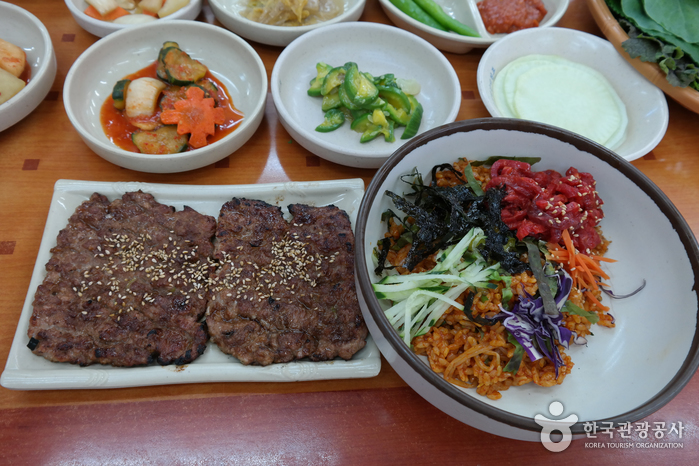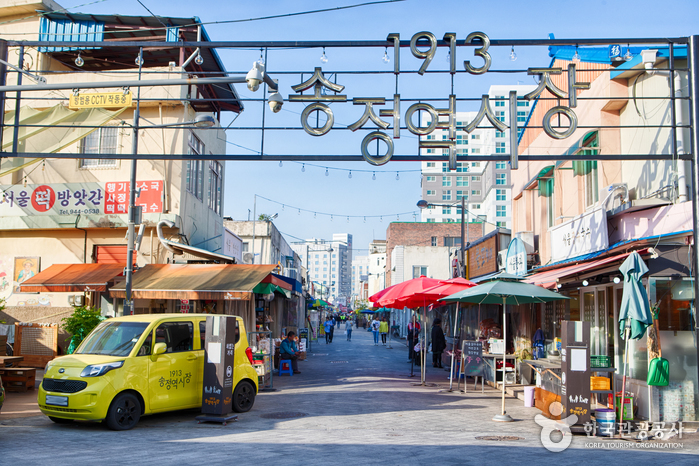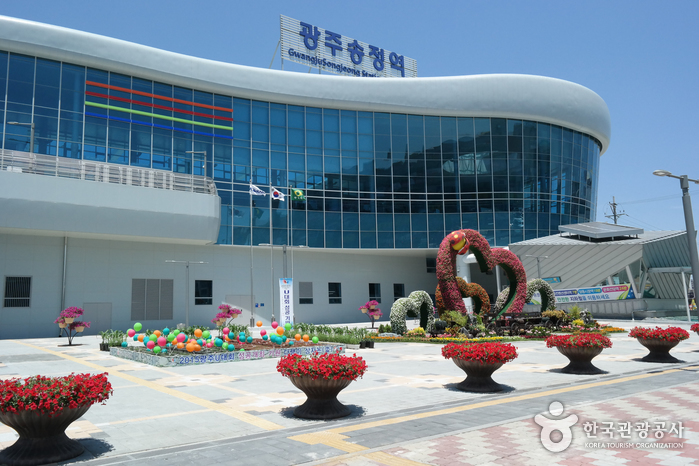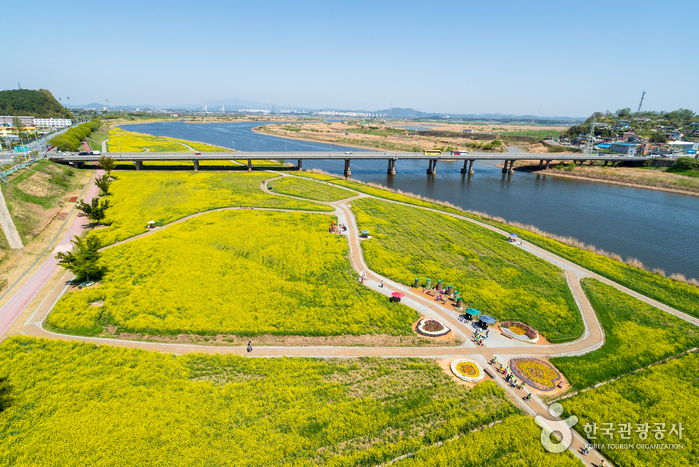Songjeong Tteokgalbi - 1st branch (송정떡갈비 1호점)
13.7Km 2020-02-21
1, Gwangsan-ro 29beon-gil, Gwangsan-gu, Gwangju
+82-62-944-1439
Songjeong is famous for its tteokgalbi (grilled short rib meat patties), which is one of the five must-eat food of Gwangju. There are many tteokgalbi restaurants around Gwangsan district office, but Songjeong’s history goes back to 1976 and making it the original store.
A good tteokgalbi is made by mixing the meat of beef short ribs and pork bone ribs in a one-to-one ratio and adding acacia honey to make the meat both tender and chewy. The dish is also reasonably priced. The secret to the delicious meat is the sauce, which is made with about 20 natural ingredients like kelp, radish, and green onion and no artificial seasonings. Also a pride of the restaurant is the broth made from pork bones which comes with the tteokgalbi.
MADRID Business Hotel Gwnagju [Korea Quality] / 유)한성 마드리드 광주호텔 [한국관광 품질인증/Korea Quality]
13.8Km 2023-04-13
11, Gwangsan-ro 19beon-gil, Gwangsan-gu, Gwangju
MADRID Gwangju Hotel located across from Gwangju Songjeong Station KTX is close to Gwangju Airport, City Hall, Kimdaejung Convention Center, and such popular areas allowing guests traveling on foot to easily visit. It also provides a pleasant environment as a business hotel as it is easy to visit Pyeongdong Industrial Complex, Sochon Industrial Complex, Hanam Industrial Complex, and Nuju Innovation City. As a new hotel opened in October 2016, it stood out as the headquarters hotel of the 2019 World Swimming Championships and is one of the top popular hotels in Gwangju with its clean facilities and friendly service.
Gwangju Aura Hotel [Korea Quality] / 광주 아우라 비즈니스 호텔 [한국관광 품질인증/Korea Quality]
13.8Km 2020-12-29
28, Songjeong-ro 1beon-gil, Gwangsan-gu, Gwangju
+82-62-942-0060
The Aura Hotel is a business hotel located just across from the KTX Songjeong Station. It provides excellent proximity and accessibility to various transportation facilities, as it is located 10 minutes from Gwangju Airport, 5 minutes from KTX Songjeong Station, 5 minutes from Gwangju Subway Songjeong Station, and 10 minutes from Gwangju 2sunhwan-ro. Also, Songjeong Tteokgalbi Special Street, 1913 Songjeong Old Market, and Songjeong 5-day Market are close to the hotel, allowing you to enjoy food and sightseeing conveniently. The luxurious room is equipped with cleanliness, cozy bedding, and a spacious bathroom, making it extra comfortable for all customers.
Mercado 1913 de la Estación de Songjeong (송정역 1913시장)
13.9Km 2023-11-14
Songjeong-ro 8-beongil 13, Gwangsan-gu, Gwangju
Estación de Songjeong de Gwangju (광주 송정역)
14.1Km 2021-03-05
Sangmudae-ro 201, Gwangsan-gu, Gwangju.
La Estación de Songjeong de Gwangju se localiza en el distrito Gwangsan-gu de la ciuda de Gwangju. La estación sirve al tren KTX (Yongsan-Mokpo). También opera una parada de autobuses interurbanos, permitiendo el fácil acceso de los turistas a otras áreas.
Hyusimjeong (휴심정)
14.2Km 2024-03-07
Imbangul-daero 611-25, Gwangsan-gu, Gwangju
Yacimiento de Dólmenes de Hwasun (화순 고인돌군 유적) [Patrimonio Cultural de la Humanidad de la Unesco]
16.2Km 2022-04-07
Hyosan-ri 64, Dogok-myeon, Hwasun-gun, Jeollanam-do.
El Yacimiento de Dólmenes de Hwasun está situado cerca de las cascadas de la cordillera que une Hyosan-ri de Dogok-myeon y Daesin-ri de Chunnyang-myeon. Según diversos estudios, 135 de las 980 rocas de Hyosan-ri en Dogok-myeon son dólmenes. También hay unas 100 rocas planas que aún mantienen su forma. En Daesin-ri de Chunnyang-myeon hay unos 124 dólmenes, de entre 3.309 rocas. Hay al menos 300 que mantienen su forma, y 23 dólmenes fúnebres. Lo que hace especiales los dólmenes de Hwasun es su abundancia, con 596 dólmenes en este pequeño distrito, incluyendo la mayor losa de Corea. El Yacimiento de Dólmenes de Hwasun fue registrado como el Patriminio Cultural de la Humanidad por la Unesco el 2 de diciembre de 2000, junto con los yacimientos de Gochang y Ganghwa.
Río Yeongsangang (영산강)
16.3Km 2021-08-26
Gaedongsingi-gil, Subuk-myeon, Damyang-gun, Jeollanam-do.
El río Yeongsangang (136 km) es uno de los cuatro principales ríos de Corea. Se trata del más pequeño de los cuatro (los otros tres son el río Hangang de 482 km, el río Nakdonggang de 522 km y el río Geumgang de 396 km de largo). El río nace en el pico Yongchubong (560 m) localizado en Yong-myeon, en el municipio de Damyang-gun, provincia de Jeollanam-do. Su recorrido transcurre por Damyang, Gwangju, Naju y Yeongam y finalmente desemboca en el Mar Amarillo cerca de Mokpo.
El río sufre de algunos retos ambientales, y algunos acontecimientos meteorológicos extremos han causado inundaciones con la pérdida de ecosistemas y la degradación del hábitat. En diciembre de 1981 se construyó una presa y los daños se redujeron. El gobierno coreano también ha implementado el Proyecto de Restauración de los Cuatro Mayores Ríos desde 2009 con el objetivo de restaurar los ríos y al mismo tiempo desarrollar las regiones. Bajo este proyecto, se invirtió mucho dinero por tal de solucionar los problemas del río Yeongsangang.
YangDongHo Traditional House (Hanok 152) [Korea Quality] / 양참사댁(양동호 가옥 / 한옥152) [한국관광 품질인증]
16.6Km 2020-12-10
24, Darasil-gil, Hwasun-gun, Jeollanam-do
+82-10-9646-5087
Yangchamsadaek (Yangdongho’s former name) or National Cultural Property No. 152 is a traditional hanok accommodation. Dalasil Village, Hwasun, Jeollanam-do, where the house is located, is a town with traditional houses and fields, where interestingly those who have the surname of Jeju Yang live together.
Yangchamsadaek is a typical noble's house in the southern region with the ㄷ-shaped main building and the ㅡ-shaped detached building form the ㅁ shale. It is expected that the main building was built in the 18th century and the detached building at the end of 19th century. In 2013, the current owner has taken over the antique house and started running a hanok stay, and his daughter, Jo A-ae, a curator and culture planner, added modern touches to turn it into a culture complex, Hanok 152. The wide lawn is sometimes rented for music performance, traditional wedding, or outdoor wedding, and other times it serves as a venue of one-day classes for hanbok experience, Korean food experience, etc.
As for rooms, there are four options: big room and small room in Anchae (main building), and Daecheong room and bed room in Sarangchae (detached building). The rooms are decorated with traditional cabinets and folding screens with embroidery, displaying the beauty of an antique house. The main floor, which is much bigger than that of other houses, has been renovated by the owner. The main floor in the main building, with a comfortable sofa and a rug, is modern and luxurious, whereas the main floor in the detached building is cozy with a floor table and Korean cushions. Toiletries are not available in the bathroom but provided upon request to the information desk. Space rental is also available. Various events such as traditional wedding, small wedding, first birthday celebration, 70th birthday celebration, small workshop, or one-day class can be held here. Moreover, traditional hanbok experience is always available at 15,000 won per person. Korean food experience is notified on Instagram and requires reservation. As the cost varies depending on the number of participants and the date, make sure to inquire over the phone.
Also located in the village are Hanjae House (National Cultural Property No. 154) and World Heritage Hwasun Dolmen Site. Note that the Unjusa Temple, famous for the Cheonbulcheontap Pagoda, is a 15-minute drive away.
Sane Flower [Korea Quality] / (주)산에는 꽃이피네 [한국관광 품질인증]
18.4Km 2020-09-03
20-1, Dongnyeok-gil, Dado-myeon, Naju-si, Jeollanam-do
+82-10-4612-4232
‘Flowers Blossoms in the Mountains’ is a hanok-style accommodation located between the House of Hong Gi-chang, a local cultural heritage, and Gyeeun Historic House (or the House of Hong Gi-eung; National Folklore Cultural Heritage No. 151) in Dorae Hanok Village. Built in 1917, the house was built with carefully selected high-quality wooden materials without using nails. It was renovated for use as tourist accommodation in 2011, opened as a hanok style of accommodation in 2013, and renovated again in 2014. On this occasion, the old doors were replaced and made into the tables that stand in the grassy courtyard.
The house has a total of 4 rooms. Each room can accommodate up to 2 to 4 people. Each room is equipped with a kitchen, bathroom, air-conditioner, TV, toiletries, plates, and so on.
This well-insulated hanok house is decorated with hanji (traditional Korean paper handmade from mulberry tree) and various antique items. Tables are available for guests in the courtyard, of which a stylish stone-paved corner stands out in particular.
There is a walkway established by Naju City in front of the house, and a vegetable garden near the house. Guests can see gourds and sponge gourds in the yard and acorn trees on the hill behind the house. In addition, the Metasequoia Street that runs through the grounds of the Naju Forest Resource Institute is just one minute’s drive from the house.
Moreover, as the village contains many houses that are classed as cultural heritages, the owner guides guests around them at weekends. Surrounding tourist attractions include Bulhoesa Temple and Najuhyanggyo Confucian School.

![MADRID Business Hotel Gwnagju [Korea Quality] / 유)한성 마드리드 광주호텔 [한국관광 품질인증/Korea Quality]](http://tong.visitkorea.or.kr/cms/resource/59/2698259_image2_1.jpg)
![Gwangju Aura Hotel [Korea Quality] / 광주 아우라 비즈니스 호텔 [한국관광 품질인증/Korea Quality]](http://tong.visitkorea.or.kr/cms/resource/66/2698566_image2_1.jpg)



![Yacimiento de Dólmenes de Hwasun (화순 고인돌군 유적) [Patrimonio Cultural de la Humanidad de la Unesco]](http://tong.visitkorea.or.kr/cms/resource/03/2515703_image2_1.jpg)

![YangDongHo Traditional House (Hanok 152) [Korea Quality] / 양참사댁(양동호 가옥 / 한옥152) [한국관광 품질인증]](http://tong.visitkorea.or.kr/cms/resource/23/2594823_image2_1.jpg)
![Sane Flower [Korea Quality] / (주)산에는 꽃이피네 [한국관광 품질인증]](http://tong.visitkorea.or.kr/cms/resource/98/2574998_image2_1.jpg)
 Español
Español
 한국어
한국어 English
English 日本語
日本語 中文(简体)
中文(简体) Deutsch
Deutsch Français
Français Русский
Русский